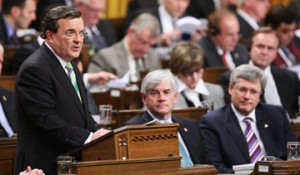 Finance Minister Jim Flaherty is giving Canada’s corporate titans the means to drive the economy—while signalling government is moving to the back seat.
Finance Minister Jim Flaherty is giving Canada’s corporate titans the means to drive the economy—while signalling government is moving to the back seat.
Thursday’s massive federal budget—at nearly 500 pages it is one-third bigger than last year’s—is chock-a-block with direct spending and incentives to help firms expand, invest and export, and measures designed to shed some of the shackles on their growth.
“They are trying to create a favourable environment in which businesses can grow,” said TD Bank chief economist Craig Alexander. “The government is telling business, ‘We carried the ball during the recession, now it’s your turn.”’
The budget suggests government is getting out of the business of stimulating the economy. In fact, Ottawa is creating a slight fiscal drag with average spending growth of 2.1% over the next five years, a rate that’s just a shade under inflation.
With consumers tapped out, the message of the budget is that future growth will have to come from exporting to other countries and business investments in plants, machinery and equipment.
The budget will help on many fronts, said Jayson Myers, president and chief executive of Canadian Manufacturers and Exporters.
“There’s a lot of good things … speedier regulatory approvals, limits on employment insurance rates, improvements on the foreign worker program, venture capital, what they are doing to support small business innovation, that’s all important stuff,” Myers said.
The budget loses marks with Myers for changes to the Scientific Research and Experimental Development program, which cut the tax credit rate and withdraw capital from eligible expenditures. That will hit Canada’s research and development heavyweights, who might export RD elsewher, he said.
But overall, business will cheer, Myers concluded.
The budget spreads modest amounts of money to business-friendly endeavours. Half-a-billion dollars of venture financing for start-ups and $1.1 billion over five years for direct research and development to help both big and small businesses become more competitive.
Funds will be funnelled into programs to help connect unemployed workers with businesses that want to hire them. Smaller firms will be given money and other incentives to hire.
The important changes for the business community aren’t measured in terms of money, but in terms of tipping playing fields in their favour.
To get firms to become more productive and innovative, the government will overhaul how it hands out billions annually in grants and tax credits for research and development.
Flaherty has long complained that Canada does not get a big enough bang for the buck on its RD spending. His budget makes it clear he believes this re-focusing on commercialization might change the current record.
“In spite of our efforts so far, Canada is not keeping up with other advanced economies on this crucial front,” Flaherty told the Commons. “The result (of the new approach) will be to position Canada to succeed in the knowledge economy of the 21st century.”
As well, the government’s measures to help green light major resource projects could have far-reaching implications given the growing global demand for Canadian oil and minerals.
Businesses will still have to manoeuvre through regulations and approvals, including environmental-impact assessments, but there will be fewer of them and they will be conducted over a shorter period of time.
Ottawa intends to telescope the number of reviews, set strict timelines and introduce a “one project-one review” process so that environmental assessments are done either at the provincial or federal level, not both.
“We won’t have ridiculous situations wher we have assessments going on for years that are sometimes abandoned because the processes take so long,” Flaherty said.




